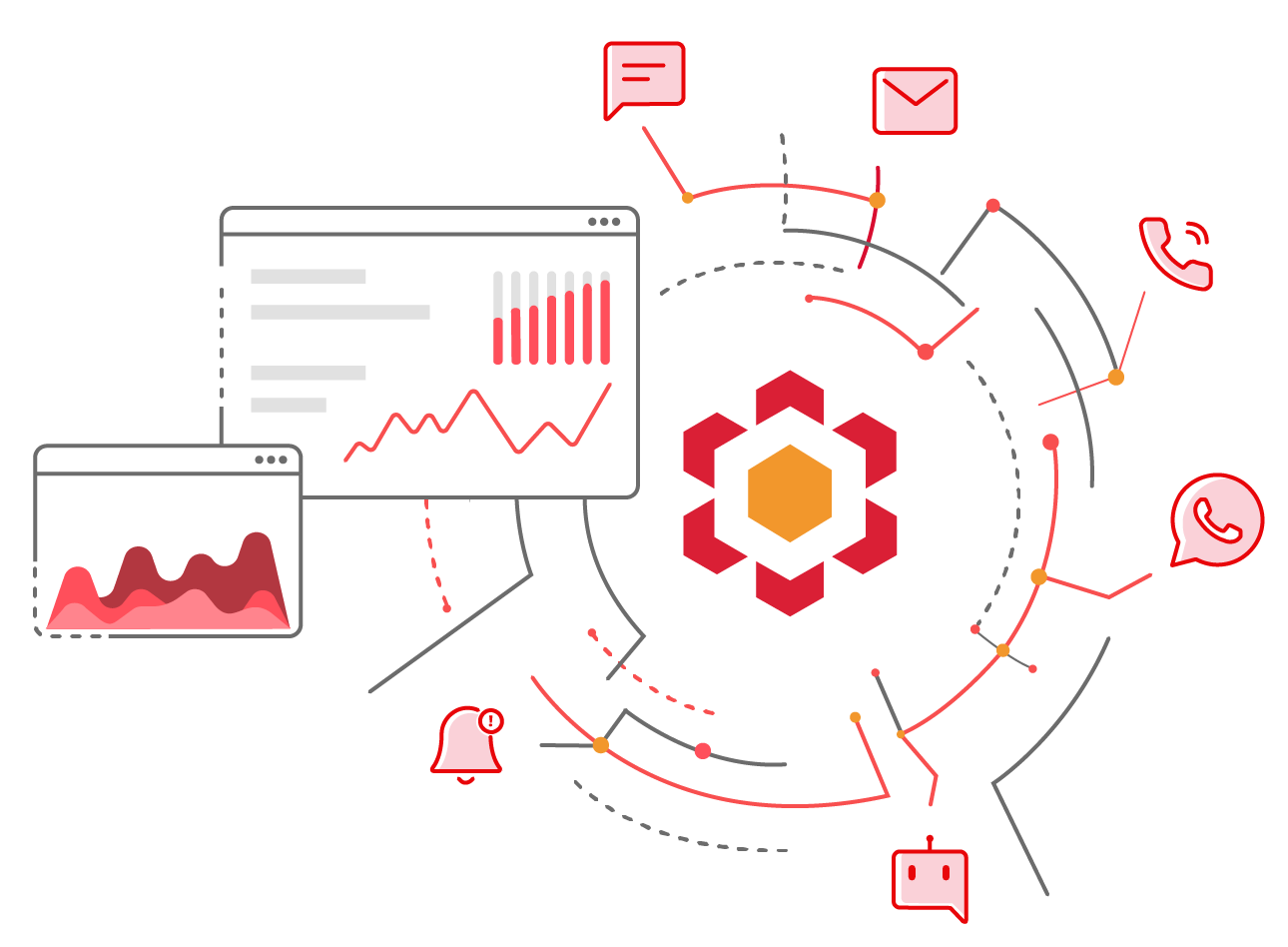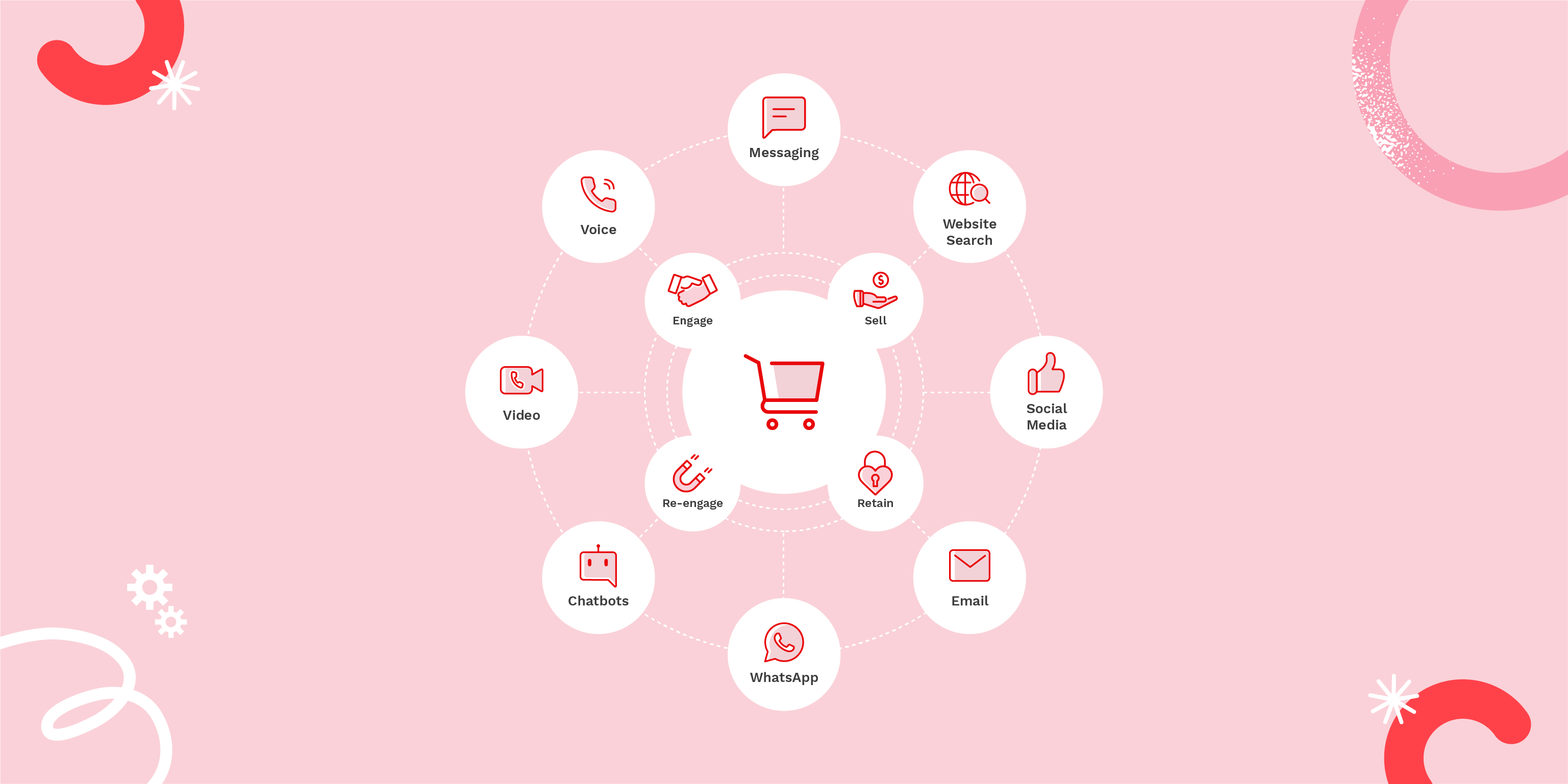
Confining your campaigns to only one channel can mean missing out on significant growth opportunities. Offering multiple channels is a step in the right direction, but it is inadequate to attract and retain modern customers. Today’s customers expect an experience that seamlessly transfers between digital and in-person, depending on their preferences. Consequently, business leaders are betting on omnichannel customer engagement strategies to deliver frictionless experiences that maximize conversions.
What is Omnichannel Customer Engagement?
Omnichannel customer engagement is all about delivering consistent experiences across all touchpoints. It is a customer-centric approach that ensures all interactions are relevant and consistent, regardless of the channel.
In an omnichannel environment, customers have the flexibility to connect with businesses through their preferred channel at every stage of their buying journey. For instance, a customer who receives an order confirmation message via SMS can seamlessly transition to the business’s WhatsApp channel to initiate a return request with customer support.
90% of customers expect consistent experiences across channels and devices. By providing consistent communication across various channels, businesses eliminate the need for customers to repeat themselves. Moreover, cohesive experiences enhance customer satisfaction and foster long-term relationships.
What Challenges Does an Omnichannel Strategy Solve?
Operational Bottlenecks
When businesses face challenges in efficiently connecting customers with the right team members, it can result in delayed and inaccurate responses. In addition to impacting customer satisfaction, siloed communication channels can disrupt sales processes. By implementing omnichannel customer engagement strategies, businesses can empower agents to manage customer interactions efficiently across various channels. Access to consolidated data ensures that agents have access to the necessary information to address customer inquiries promptly.
Fragmented Customer Experiences
When customer interactions across different touchpoints lack cohesion, it affects brand perception. For example, if promotional offers on different channels have varying terms and conditions or conflicting product information, it leads to distrust.
Efficiency Gaps
When communication channels are not aligned, it often results in redundant workflows and manual processes, increasing the likelihood of errors and delays. End-to-end cloud communication platforms automate repetitive tasks and streamline communication flows by integrating different systems.
Lack of coordination between disparate channels impacts the ongoing customer experience, leading to inconvenience or frustration when using the product or service. For example, say a customer has already renewed their annual subscription by responding to a WhatsApp message offering a personalized discount for renewal. If the customer continues to receive repeated SMS reminders for renewal, it can cause frustration.
Lack of Strategic Insights
Siloed communication can affect a business’s ability to leverage customer data for valuable insights to deliver personalized experiences. Moreover, teams cannot make timely, informed decisions without a unified view of data, which is vital for driving conversions. For example, sales teams may lack visibility into customer support interactions, leading to missed opportunities for cross-selling or upselling.
EBOOK
Scaling Communications: CPaaS and Global Expansion
Learn how to unlock the potential of CPaaS for seamless global communication and unprecedented success.

Benefits of Omnichannel Engagement
Optimization of Customer Journey
Omnichannel customers have a 30% higher lifetime value than those who purchase on only one channel. In an omnichannel environment, customers can seamlessly transition between different channels. Moreover, empowering customers to choose the channel they are comfortable with along their journey improves customer satisfaction.
More Reach
By enhancing their presence across multiple channels, businesses can maximize opportunities for customer engagement and conversions. With different customers having different preferences, an omnichannel presence allows businesses to reach a wider audience and cater to diverse needs.
Data-Driven Insights
Omnichannel engagement helps businesses use a wealth of consolidated data from customer interactions across channels. Insights into customer behavior and preferences inform decision-making, such as product roadmaps and marketing campaign optimization for business success.
Brand Recognition
Omnichannel engagement ensures customers have consistent messaging experiences across all channels. When customers encounter the same tone of voice and messaging everywhere, it reinforces brand identity, building trust and credibility.
Adaptability and Flexibility
With customer preferences and behaviors constantly evolving, omnichannel engagement allows businesses to be agile in their communication strategies. By diversifying their interaction points, businesses can gain a competitive edge and remain on top of customers’ minds.

-
Build a Powerful Omnichannel Engagement Strategy
Here are a few steps for a successful omnichannel strategy –
Know Your Customers
Understanding your user personas is crucial for an effective omnichannel strategy. Consider factors such as geographic location and demographics to determine the most suitable communication channels to reach your audience.
For instance, in regions where apps like WhatsApp have a significant user base, incorporating the messaging channel into your omnichannel strategy can be advantageous. Similarly, traditional channels like SMS may be more effective if your target demographic includes individuals aged 65 and above. By engaging with customers on a familiar platform, you can build deeper connections.
Alignment of Channels
Make sure your messaging strategy is optimized for each channel. With channels having distinct features, crafting the right message for each channel lets you make the most of its capabilities.
For example, WhatsApp allows CTA and Quick Reply button messages, which makes it convenient for users to continue the conversation. Similarly, SMS may be an excellent channel for sending transactional messages such as delivery updates and reminders.
Moreover, you can streamline communication by integrating your channels with business systems such as CRM, marketing automation tools, and payment gateways.
Leverage Data for Contextual Conversations
Managing data across multiple platforms and teams can be challenging, leading to potentially misleading insights. An omnichannel environment centralizes data and provides a comprehensive view of each customer’s journey. Easy access to accurate data helps you understand customer preferences and sentiments for tailored interactions.
For example, if a customer has recently booked a flight ticket to a tourist destination, they might appreciate receiving accommodation recommendations for their upcoming trip. Contextual conversations demonstrate that you understand customer needs, enhancing engagement. Moreover, a proactive approach fosters trust and encourages brand loyalty.
Use the Right Omnichannel Platform
Choose a robust omnichannel platform, such as Kaleyra, where interactions on one channel complement those on others. With the right technology, you can deliver memorable customer experiences effortlessly.
Omnichannel solutions that facilitate interactions across various channels, such as SMS, WhatsApp, Voice, Video, and AI chatbots, allow your business to elevate your communication strategy. Moreover, platforms that support integration with existing business systems help improve operational efficiency.
Balance of Automation and Human Support
While today’s customers expect prompt responses, they also value authentic business interactions. Automating tasks with AI chatbots helps businesses be available 24/7, improving customer service. Yet, many customers crave human connection when discussing sensitive issues or requiring immediate assistance.
For example, insurance customers facing a challenging situation, such as filing a claim after a car accident or experiencing property damage, would appreciate empathy from human agents.
A healthy mix of automation and human connection ensures that customers get efficient support while feeling valued and understood.
Monitor, Analyze, and Improve
Track key metrics, such as the number of conversations initiated, to measure the performance of each channel effectively. Monitoring engagement metrics like click-through rates helps understand the channels that resonate most with your target audience.
For instance, if you find SMS campaigns perform well for sale alerts, you can allocate your resources accordingly. Similarly, if you observe that customer satisfaction metrics improve significantly with WhatsApp, it signals an opportunity to leverage the channel more extensively.
With Kaleyra’s omnichannel solution, businesses can navigate the complexities of modern customer engagement effortlessly. With Kaleyra as your omnichannel partner, you can unlock the full potential of omnichannel customer engagement and take your business to new heights.

Kalaivani Narayanan
Content Specialist
Supercharge Your Communication!
Get in touch with our experts who strive hard to bring the very best in cloud communications technology to you.

